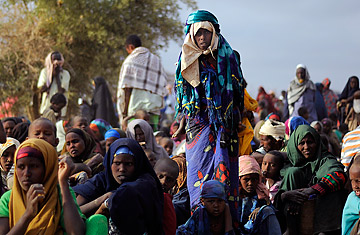
Somali refugees wait at a registration center at the Dagahaley refugee site within the sprawling Dadaab complex in Kenya on Aug. 2, 2011
We have been driving around the world's largest refugee complex, late for an appointment with an NGO, as we are lost amid seemingly endless rows of ramshackle huts built of sticks and discarded packaging from aid organizations. The driver is making me nervous as he steers recklessly through women in hijabs, children with bare feet and men with donkey carts, moving through the narrow roads of desert sand. The hired guard, a moonlighting soldier, seems at ease, chatting loudly on his mobile phone as he cradles his machine gun in the other hand.
Realizing that we are lost, we park near a dried-out tree on the edge of the Hagadera refugee camp, one of the three in the Dadaab complex in eastern Kenya, when a man runs toward me shouting, urgently asking for help. What happens next seems to be a metaphor for the crisis that has overtaken this portion of the country, now the safe haven for the tens of thousands of people fleeing the world's worst hunger crisis, a famine that has gripped war-torn Somalia, the result of the worst drought in the region in 60 years.
The man, an aid worker named Maash, tells me that a woman who has just given birth is hemorrhaging and needs to get to a hospital right away. The woman, called Mrs. Hassan, has just arrived in the camps after walking for two weeks — she is one of tens of thousands escaping from Somalia into Kenya. With her is another new mother, who looks to be barely out of her teens, cradling a severely malnourished child. There is no ambulance available.
We get into the car and drive off toward the hospital, but after just a few minutes, we are stuck in the sand. The driver, a surprise substitution for my professional driver the day before, does not seem to have experience driving in the off-road conditions of the camp. Passersby try to help push us out while the wheel spins. Inside, the women sit quietly, their faces tight, showing little expression. I am scared. Our car is freed then gets stuck a second time. We dig the wheels out, push, and finally the SUV gets moving again.
Thousands of Somalis are facing similar health crises and are forced to fend for themselves. They face a grueling, dangerous journey with little food or water. According to Médecins Sans Frontières, 1 out of 3 newly arrived children suffers from acute malnutrition. Once the refugees arrive at the camps, they find they face an entirely new struggle: the camps have been closed since 2008 because of severe overcrowding. Filled up as the result of the Somali conflict in the past two decades, they are now four times their capacity. New arrivals are forced to end up on the outskirts of the camps, and there are more than 380,000 people in the camps and the outskirts. Newcomers, now arriving at a rate of 1,400 per day, are left to build their own shelters in the desert on the edges of the established camps. Their number has reached over 70,000. Despite the heroic efforts of NGOs working in the area, many people have little access to clean water, toilets, security or medical care. The U.N. refugee agency is starting to move people in the outskirts to a new tent camp, but that is not expected to be completed until November. Meanwhile, news reports from Somalia say that the Islamic militant group al-Shabab is preventing hungry people from fleeing the country.

The Dadaab refugee-camp complex, pictured on July 28, 2011, and the outskirts now shelter around 380,000 people
(Photo by Corentin Fohlen / Sipa)
One senior aid official in Dadaab says that while his organization is gratified to see promises of millions of dollars from the U.S., Europe, Saudi Arabia and other wealthy countries in the wake of the recent media coverage of the crisis, it is also very frustrating because in fact the crisis has been going on for many years and the drought was forecast a year ago. The chaos that is happening now is unnecessary, he says. "It is the procrastination by everybody in world; they wait until the situation gets out of hand."
